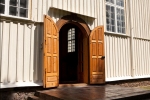September 2007
Christian Hospitality
Newcomer Incorporation: A Countercultural Activity
Many of us have heard the old saying “Everybody who should be an Episcopalian already is.” We laugh nervously when we hear it because we realize that the adage reveals, perhaps, a truth about American Anglicanism of which we are not particularly proud.
In their 1978 tongue-in-cheek expose entitled The Power of Their Glory — America’s Ruling Class: The Episcopalians, Kit and Frederica Konolige observe that Episcopalians possess “a preference for family expansion rather than missionary activity as a means of growing as a religion.” This, coupled with the fact that in many communities, the Episcopal Church has historically functioned as a refuge for the social elite, has led many members of our small but influential denomination to believe that everyone with good sense, and certainly everyone with good taste, would beat a path to our doors.
This cherished belief was first questioned in the ‘60’s. Prayer Book revision, the church’s stand on civil rights, the ordination of women, and more recently, the debate on human sexuality have all caused many to beat a path to the exit doors. As a result, the Episcopal Church began in earnest to enter into the art of evangelism, until then a countercultural activity.
Our most important evangelistic activity
The ministry of welcoming newcomers into our midst is arguably the most important evangelistic activity in which a parish can engage. Gone are the days when people just plopped down at the nearest church.
New residents of a community unabashedly “church-shop,” often visiting parishes several miles from their home, and choose congregations based on a variety of criteria — music, preaching, Christian education, churchmanship, and politics — namely, where a given parish stands on the conservative-progressive continuum. And in a day when “brand loyalty” is no longer a given, a recently relocated family with roots in the Episcopal Church may well choose a Methodist congregation because its youth program better meets the needs of their children.
Of course, this cuts both ways. Our liturgy and our reputation as a church that doesn’t require its members to check their brains at the door continue to be beacons to those of other traditions. Many Episcopalians, for example, count among their membership former Presbyterian-Roman Catholic couples, who find in the Episcopal Church a spiritual and theological via media.
Intentionality begins the process
We at Calvary do not believe that we have by any means perfected the newcomer process, but we have met with modest success by incorporating the following principle: intentionality. For the reasons outlined above, newcomer ministry cannot be left to chance. This means that vestries must allocate personnel, time and resources to the newcomer effort.
We must also be intentional for another reason. Our church building, described in a local newspaper recently as “44,000 square feet of Gothic Revival prominence,” is not, on its face, warm and welcoming. Our behavior, therefore, must serve to counteract the possibly chilling effect of tons of Indiana limestone.
During the announcements at the Sunday Eucharist, we welcome all newcomers and invite them to stand, and they are presented with loaves of bread, baked by our Parish Loafers. Some newcomers, having sought anonymity on their church-hopping tour, opt not to stand, but we know they appreciate the welcome, because they do identify themselves to the clergy at the west door following the service. Attached to the loaf of bread is an information card (also found in the pew rack) which we ask the newcomers to fill out.
Secondly, we bombard newcomers with information. A packet is mailed immediately following the first visit, containing a letter from the rector, the parish newsletter, music and Christian Formation brochures, copies of recent sermons, a list of parish programs and outreach activities, a pledge card and other materials.
Our curate, whose portfolio includes newcomer incorporation, follows up with a phone call, e-mail or personal visit as appropriate. (I am guided by the testimony of a parishioner who explained that she chose our parish after a church-shopping tour thirty years ago because on the Wednesday after her visit, one of the parish clergy appeared on her doorstep!)
The parish also follows up with an invitation, either to a brunch at the home of the rector or warden, or to a foyer group, “cells” of about a dozen or so new and old members who gather periodically for dinner and conversation. We find this an effective way to foster relationships which would otherwise be difficult to do in a large congregation.
No less important are “on-site” invitations extended by parishioners to join them at coffee hour, or an offer to help the visitor navigate through the Prayer Book or the Sunday bulletin. An Inquirers’ Class, led by members of the parish staff, is offered to newcomers (and oldtimers) at least twice a year. Using James Griffiss’ The Anglican Vision or a similiar book we provide an introduction to the faith as this church has received it for those from other traditions (or a refresher course for Episcopalians who may have had little instruction since their Confirmation class).
More than pew-warming
All of these steps lead to involvement. Evangelism experts tell us that newcomer incorporation is not complete until the person has a job other than pew-warming. Serving on an outreach committee, volunteering in the bookstore, or reading a lesson means that the newcomer has a stake in parish life. When all is said and done, newcomer incorporation is about extending hospitality, an act which, the Epistle to the Hebrews reminds us, may result in entertaining angels unawares.
The Rev. Dr. Harold T. Lewis, an Episcopal Church Foundation fellow, is rector of CalvaryChurch, Pittsburgh, Pennsylvania, and Adjunct Professor of Church and Society at Pittsburgh Theological Seminary.






